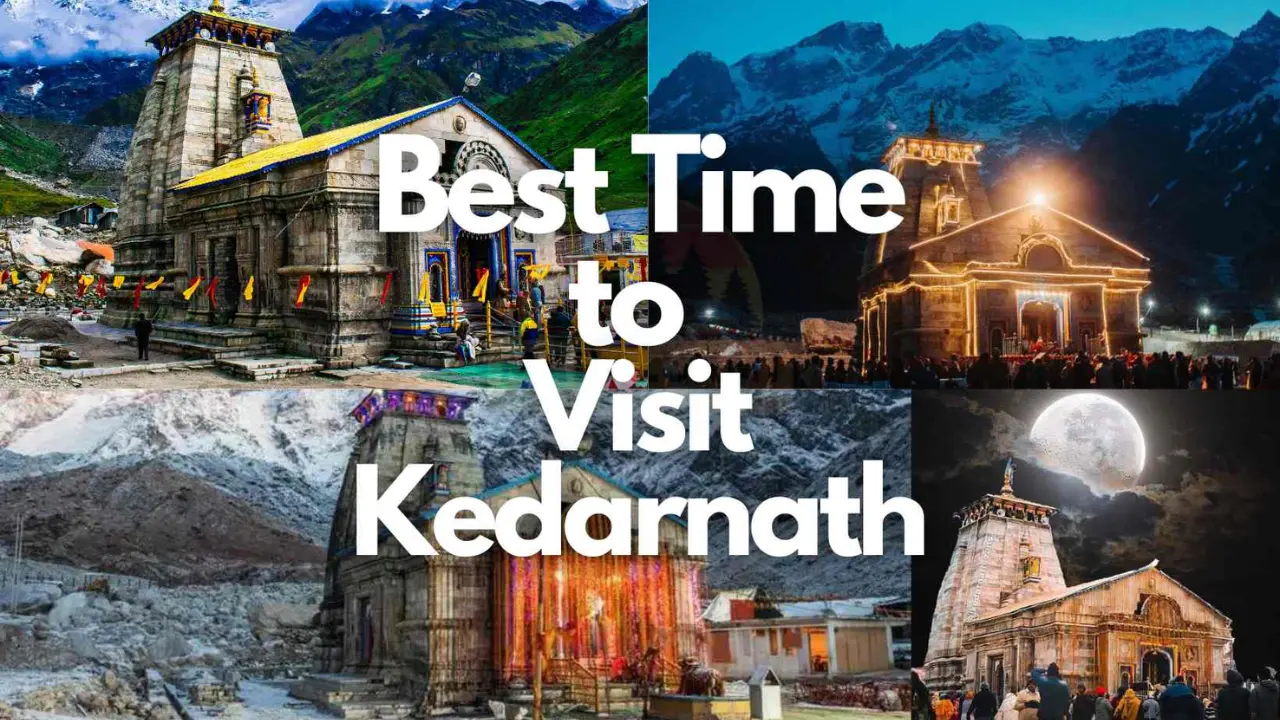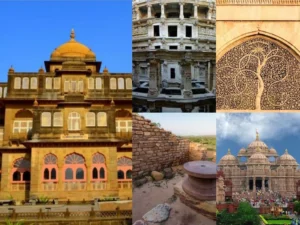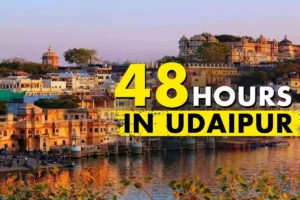April to June is the best time to visit kedarnath, offering pleasant weather and accessibility for pilgrims and tourists alike. During this period, the temperature ranges from 5°C to 20°C, the snow begins to melt and the famous Kedarnath Temple becomes accessible to devotees. May is a peak month and remains crowded. The doors of the revered Kedarnath Temple open in late April or early May, marking the commencement of the pilgrimage season. The pre-winter months from September to October is another good time to visit Kedarnath Temple.
Kedarnath remains closed for 6 months from November to March each year due to snowfall in the region (Exact dates are announced every year). After November, the region experiences heavy snowfall, making it challenging and unsafe for travel. During this time the temperature ranges from around 5 degrees Celcius to 18 degrees Celcius. The monsoon season in Kedarnath lasts from July to August and brings heavy rainfall, causing landslides and hindrance.
Best time to visit Kedarnath
Spiritual as well as adventure-laced, you can never go wrong if you take a detour to Kedarnath, while at Uttarakhand. Yet owing to its extremely cold climate, spending your summers in Kedarnath would be a preferable idea – April to June is the best time to visit Kedarnath. This is when the Kedarnath weather is soothing and warm, unlike the chilling temperatures of winter, and you can move around the place comfortably. The monsoon is unreliable, and can vary from scant precipitation to heavy showers.
Nestled in the high folds of the Himalayan mountain range in Rudraprayag district, Kedarnath is one of the ‘Char Dhams’ that many Indians visit during their lifetimes. The destination finds immense reverence among the followers and devotees of Lord Shiva who resides in Kedarnath as Lord Kedar. The whole place echoes with mythology and has immense historical significance to this nation. It is considered to be the permanent abode of the god, and the venue opens its doors for devotees in the months of summer, which is the best climate to visit Kedarnath.
Whenever you decide to head to this ancient pilgrimage centre, you are sure to be awestruck. Not just by the Kedarnath temple and its associated spirituality, but also by the sheer beauty of the landscape that surrounds this temple town.
Summer Season (April-June)
The best season to visit Kedarnath is summer when the temperature is moderate and stays between 15-30 degrees Celsius. The sun is warm and there is a gentle cool breeze that makes the day pleasant. With the weather backing you, this is the ideal time to visit Kedarnath temple, Panch Kedar and Chota Char Dham, among other highlights of the area.
Monsoon Season (July-September)
Kedarnath weather during monsoon is unpredictable. Overall the region doesn’t receive much rainfall, but when it does rain heavily, it could lead to landslides and the possibility of roadblocks. Unless you wish to be adventurous, it is best if you avoid this season and plan your spiritual vacation in the summer.
Winter Season (October-March)
When you are visiting the Himalayas in winter, expect freezing cold temperatures. Winter in Kedarnath will test your endurance and leave you breathless in more ways than one. The landscape is beautiful, but you will have to brave Kedarnath temperatures below freezing point at times. The land does see sunny days, but overall, winter is a cold time in Kedarnath.
| Travel Seasons | Min/Max Temperature | Season |
| April to June | 15-30 degrees | Summer – Cool and comfortable |
| July to September | 12-27 degrees | Monsoon – Moderate rains with chances of landslide |
| October to March | 0-20 degrees | Winter – Freezing cold |
Kedarnath In Summer (April To June)
Temperature – Avg. of 30 degrees high to 15 degrees low
Weather
Kedarnath is always cold; it’s just that the degree of coldness varies. The summer months of April, May and June are cool and pleasant, making them perfect for sightseeing. The average temperature is usually around 17 degree Celsius, and with the warm sun for company, you can spend your time walking about the place. Besides visiting the main Kedarnath temple, you can use your time to make a pilgrimage to the other shrines that dot this beautiful mountain town. Lord Shiva is the main presiding deity, but there are temples dedicated to several other gods too.
Kedarnath during summer calls out to adventure seekers. Whether you are spiritually inclined or not, once you are done paying homage at all the temples, you can head off on the many trails scattered around the town. While the climb itself could be a bit difficult, you will find the weather to be perfect for outdoor trekking and hiking.
Significant events
If you happen to be in Kedarnath during June, you will get to experience the colourful Badri Kedar Festival. The entire region is festooned with decorations and the land takes on a festive mood. Summer is the best time and place to witness the culture and traditions of Devbhoomi Uttarakhand. For eight whole days, the land is brimming with artists from various parts of Uttarakhand who have come here to display their art. Singers, dancers, painters and other craftspeople use this platform to showcase their talents and also to spread awareness about the history, tradition, culture and beliefs of this Himalayan state.
Why you should visit now – Kedarnath weather doesn’t get any better than in summer. The cold has receded and you will find the weather comfortable for walking around the town and the adjoining areas.
Know before you visit – This is peak tourist season and you will encounter crowds. Be prepared to wait in line at the temples.
Tips – Carry along energy bars and dry fruits when you are outside. Those are perfect for the needed burst of energy in this steep region.
Monsoon (July To September)
Kedarnath Temperature – Avg. of 27 degrees high to 12 degrees low
Weather
The monsoon in Kedarnath starts in July and continues well into mid- September. While the weather in the monsoon of Kedarnath is not a great time to visit, it still receives a fair share of tourists who come seeking a bit of a thrill. Do take note, the temple of Kedarnath remains shut during this season since the devastating flash floods of 2013. The place is beautiful, no doubt, and adventure seekers make a beeline to the region. This is when trekking and hiking can be doubly exciting, and if the weather cooperates, the climate is actually pleasant. If the area experiences heavy rainfall, the possibility of landslides and thus, blocked roads, increases exponentially. If you must visit in this season, come prepared to enjoy the raw beauty of largely untouched land.
Significant events
A day before the joyful festival of Raksha Bandhan in August is the Shravani Annakoot Mela. This is a colourful fair and is celebrat by the local people to mark the new harvest. On this day, freshly-harvest paddy is offered to the lord’s idol as ‘prasadam’. The phallus-shaped idol of Lord Kedarnath is decorated with a paste made from the fresh grain. Several prayers and other religious rituals are conducted on this day. The festival is a visual treat for tourists, and it also creates a spiritual experience for all those visiting Kedarnath Dham on this day.
Lord Ganesh is Lord Shiva’s son, and his birthday is celebrated with much fanfare in Kedarnath. Vinayak Chaturthi comes around September and Lord Ganesha’s devotees flock to the temple to pay homage to the lord of happiness and prosperity.
Why you should visit now – The monsoon turns the otherwise barren land of Kedarnath into an unending spread of lush green hills and mountains, with gushing streams. It’s perfect for being outdoors.
Know before you visit – You might think that nobody visits Kedarnath in the monsoon, but there are plenty of adventure-seekers like you, so expect to see crowds.
Tips – Carry a monsoon emergency day pack with spare clothes, a poncho, torch, extra batteries, bottle of water and dry fruits.
Winter(October-March)
Temperature – Avg. of 20 degrees high to 0 degrees low
Weather
Kedarnath during the winter months is rather inhospitable. The area receives heavy snowfall and most roads end up being blocked. The temperature also drops to sub-zero numbers and if you are not accustom to the cold, it can be quite uncomfortable to be in Kedarnath during winter. The temple too takes a break from the crowds and remains shut all of winter. Heavy snow piles up everywhere and tourists are not encouraged to visit the temple town in winters. The weather of Kedarnath in winter is such that in fact, many locals also leave before winter arrives, turning Kedarnath into a ghost town of sorts. Additionally, the place is shrouded in white, and it gives Kedarnath an ethereal aura.
Significant events
Like any other part of the country, Diwali is celebrat with much enthusiasm in Kedarnath too. This festival of lights sees the region come to life with hundreds of colourful flower and thousands of glittering lamps that are use to decorate the temple and its surrounding area. This is a big event and many celebrities come to Kedarnath to pay their homage to the deity during this auspicious time. Whether you are a Shiva devotee or not, you must try and experience this festival at Kedarnath at least once in your lifetime.
It is believe that the great sage Adi Shankaracharya breath his last at Kedarnath. His Samadhi, a shrine dedicated to him, is located just behind the main temple of Kedarnath. Once every year on the closing day of the temple, a Samadhi Puja is conduct. Pilgrims flock to Kedarnath from far to attend this celebration of lights, music and processions. A grand puja is perform inside the Shankaracharya Samadhi and then the sanctum of the main temple is close for winter. The idol of the presiding deity is shift to Ukhimath where it continues to be worshipp.
Why you should visit now – Not many people visit Kedarnath during winter. If you are willing to brave the harsh weather, this is a time when you can get good deals on hotels.
Know before you visit – Be prepar for roadblocks. Carry an emergency day pack with you and make sure it includes spare clothes, waterproof woollen gloves. Torch, extra batteries, a bottle of water and dry fruits.
Tips – Wear a pair of comfortable, waterproof trekking shoes when you head out on the icy slopes.
Kedarnath is shroud in clouds and mythology. When you visit this Himalayan town, you will feel the pull of the past. If you wish to explore the virgin terrain of the Himalayas, there is no better place than Kedarnath. Browse through our section on Kedarnath Tour Packages and you will see how easy. It is actually to reach this far-flung destination. Whatever your queries and doubts, we are sure to have answers to them all in this section. You can also read up on tips and handy hints to make the most of your trip to Kedarnath. At Thomas Cook, we can help you with your travel tickets and hotel accommodation. You can also use our services to apply for your visa and Indian currency needs.
Also Read: Kedarnath Opening Date
Conclusion
Kedarnath offers a blend of spirituality and adventure, drawing pilgrims and tourists throughout the year. However, the best time to visit is from April to June when the weather is mild. Ranging from 15 to 30 degrees Celsius. Making exploration of the temple town and surrounding areas comfortable. This period marks the opening of the revered Kedarnath Temple, inviting devotees for pilgrimage. Monsoon, from July to September, brings lush greenery but also the risk of landslide. While winter, from October to March, envelops Kedarnath in heavy snow and freezing temperatures, rendering it inhospitable for most visitors. Despite the challenges, each season presents unique experiences, from festive celebrations to serene solitude. Whether seeking spiritual solace or an adrenaline-fueled adventure. Planning a trip to Kedarnath requires consideration of weather conditions and personal preferences to ensure a fulfilling journey.




